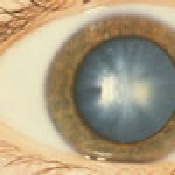
Recently, I learned about a fascinating study in which researchers have proposed a possible (but not proven) genetic link between Alzheimer’s disease and age-related cataracts.
The Public Library of Science (PLoS)
The study, entitled Delta-Catenin Is Genetically and Biologically Associated with Cortical Cataract and Future Alzheimer-Related Structural and Functional Brain Changes (I will explain/decode!), was published in the September 11, 2012 issue of PLoS ONE, an international, peer-reviewed, open-access online journal, published monthly by the Public Library of Science (PLoS). The PLoS is a non-profit organization of scientists and physicians who are committed to making the world’s scientific and medical literature a freely available public resource.
The authors are Gyungah Jun; Juliet A. Moncaster; Carolina Koutras; Sudha Seshadri; Jacqueline Buros; Ann C. McKee; Georges Levesque; Philip A. Wolf; Peter St. George-Hyslop; Lee E. Goldstein; and Lindsay A. Farrer, representing the following institutions: Boston University Schools of Medicine and Public Health; University of Toronto; Bedford (MA) Veterans’ Administration Hospital; Université Laval, Québec; and the University of Cambridge. The study subjects included 1,249 members of the ongoing Framingham Eye Study.
About Delta-Catenin
Delta-catenin is a protein that is expressed in the brain and is important for normal cognitive development. It is also written as d-Catenin, using the Greek letter/symbol for “delta.” Delta-catenin is also being investigated for its possible biological role in the development of certain types of cancers.
About Cortical Cataracts

“Cortical” refers to white opacities, or cloudy areas, that develop in the lens cortex, which is the peripheral (outside) edge of the lens. Changes in the water content of the lens fibers create clefts, or fissures, that look like the spokes of a wheel pointing from the outside edge of the lens in toward the center. These fissures can cause the light entering the eye to scatter, creating problems with blurred vision, glare, contrast, and depth perception.
About the Framingham Study
The Framingham Study, which began in 1948, is a multi-generational community-based study that has examined a group of men and women every two years to determine the incidence and prevalence of cardiovascular disease and its risk factors.
In 1971, the Framingham Study began a study of the offspring of the original group, including data collection on blood pressure, cigarette smoking, weight, and other factors that are of interest to studies of eye disease.
Researchers conducted eye examinations between 1973 and 1975 on the survivors of the original group (Framingham Eye Study I) and between 1986 and 1989 (Framingham Eye Study II). The offspring received eye examinations from 1989 to 1991 (Framingham Offspring Eye Study). Data from these eye exams have been used to examine risk factors for cataracts, diabetic retinopathy, myopia, and glaucoma.
In 1999, dementia-free surviving members of both the original and offspring Framingham [groups] were invited to undergo a magnetic resonance imaging (MRI) examination of the brain. Repeat measurements were obtained from a second MRI scan performed 2.6 years and 6.2 years later, on average, in the original and offspring [groups], respectively.
The Study Basics
From the Introduction:
We hypothesized that common genetic mechanisms govern age-related changes in lens and brain, and that these changes can be detected earlier in the lens.
In the current study, we demonstrated that measures of cortical lens opacity in midlife and neuro-degeneration in later life are heritable and correlated among participants in the Framingham Study, a population-based, family-structured cohort.
For the … genetic/hereditary analysis, we focused on 1,249 members of the offspring [group] for whom ocular, MRI, and genome data were publicly available.
More about the Research
From the study summary in Science Daily:
Using the Framingham Offspring Eye Study cohort, investigators looked at brain MRI findings on or after 10 years from the original eye exam and concluded that there was a significant correlation between a quantitative measure of cortical cataract and several Alzheimer’s disease-related measures of brain degeneration, in particular volume of the temporal horn which is a brain structure that is progressively enlarged in patients with Alzheimer’s disease.
Another strong correlation in these same individuals, between cortical cataract formation and poorer performance on several cognitive tests administered at the time of the MRI scan, further supports this link.
In addition, the researchers found increased deposits of delta-catenin in lens tissue obtained from autopsy-confirmed Alzheimer’s cases, but not from subjects lacking Alzheimer’s-associated neuropathology.
“Though much work remains to be done, a link between cataracts and Alzheimer’s disease supports the idea of a systemic rather than brain-limited focus for processes leading to Alzheimer’s disease,” said senior author Lindsay A. Farrer. “This study gives hope that we are moving toward earlier diagnosis and new treatment targets for this debilitating disease.”
Conclusions from the Research
From a interview with senior study author Lindsay A. Farrer, Ph.D., in The Montreal Gazette:
“Not everyone who gets cataracts gets Alzheimer’s,” Farrer said in a telephone interview. “What we demonstrated is the pathways leading to these disorders have some common vertex.”
This link may one day become a new biomarker for Alzheimer’s, said Farrer. This study is also looking for ways to identify Alzheimer’s before the brain damage occurs. For the time being, however, Farrer admitted that people aren’t rushing to seek early diagnosis because there is no cure.
But this new study “gives biologists a new avenue to pursue,” he said — and that may offer new hope to Alzheimer’s patients.
VisionAware will provide research updates as they become available.